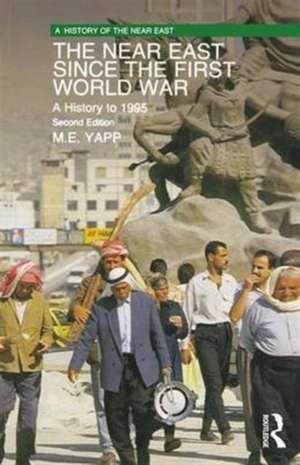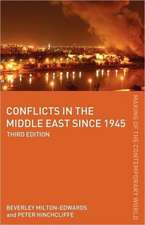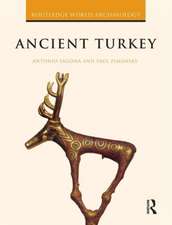The Near East since the First World War: A History to 1995: A History of the Near East
Autor Malcolm Yappen Limba Engleză Hardback – 15 apr 2016
| Toate formatele și edițiile | Preț | Express |
|---|---|---|
| Paperback (1) | 399.21 lei 6-8 săpt. | |
| Taylor & Francis – 27 iun 1996 | 399.21 lei 6-8 săpt. | |
| Hardback (1) | 1000.27 lei 6-8 săpt. | |
| Taylor & Francis – 15 apr 2016 | 1000.27 lei 6-8 săpt. |
Preț: 1000.27 lei
Preț vechi: 1219.84 lei
-18% Nou
191.46€ • 208.04$ • 160.93£
Carte tipărită la comandă
Livrare economică 22 aprilie-06 mai
Specificații
ISBN-10: 1138142379
Pagini: 616
Dimensiuni: 138 x 216 mm
Greutate: 0.45 kg
Ediția:Revised
Editura: Taylor & Francis
Colecția Routledge
Seria A History of the Near East
Locul publicării:Oxford, United Kingdom
Cuprins
SECTION I: THE YEARS OF THE NOTABLES.
1. Egypt to 1952.
2. Iraq to 1958.
3. Syria and Lebanon to 1958.
4. Palestine and Transjordan to 1950.
5. Turkey to 1950.
6. Iran to 1960.
7. Arabia to the 1960s.
SECTION II:
8. Egypt 1952-89.
9. Iraq 1958-89.
10. Syria and Lebanon 1958-89.
11. Israel, Jordan and the Palestinians.
12. Turkey 1950-89.
13. Iran 1960-89.
14. Arabia from the 1960s to 1989.
SECTION III: THE NEAR EAST IN INTERNATIONAL RELATIONS
15. European Predominance and Its Decline 1923-56.
16. Superpowers and Regional Powers 1956-89.
SECTION IV: THE NEAR EAST 1989-95.
17. Introduction: Changes 1989-95.
18. Egypt 1989-95.
19. Iraq 1989-95.
20. Syria 1989-95.
21. Lebanon 1989-95.
22. Israel 1989-95.
23. Jordan 1989-95.
24. The Palestinians 1989-95.
25. Turkey 1989-95.
26. Iran 1989-95.
27. Arabia 1989-95.
28. International and Regional Affairs 1989-95.
Bibliographical Guide.
Glossary.
List of Rulers.
Maps.
Index.
Descriere
Notă biografică
M.E.YAPP is Emeritus Professor of the Modern History of Western Asia at the School of Oriental and African Studies, University of London.
Textul de pe ultima copertă
A HISTORY OF THE NEAR EAST
General Editor: P. M. Holt
"Students, teachers and general readers will welcome this long overdue textbook, and they wil be delighted that it includes Turkey, Iran and Arabia as well as the usual countries contained in in works on this part of the world. Primarily a political history, it also contains summaries of the economic and social change in the area since the First World War. An introductory chapter sets out the socio-economic and political context, followed by country studies in two sections entitled 'The Years of the Notables' (to the 1960s) and 'The Years of Revolution' bringing us almost up to date. A final section looks at 'The Near East in International Relations'. The extended note on names and titles is useful, and the bibliographical guide at the end provides one of the best surveys I have seen of works in English. In short it should be essential reading for students and it is also an authoritative and accessible reference work for anyone interested in the Near East."
So wrote Paul Lalor in the Times Higher Education Supplement when the First Edition of this celebrated book was published in 1991. At that time it ran through to 1989. Now, Professor Yapp has fully updated it, to cover events down to the end of 1995, in a new 60-page final section on 'The Near East 1989-95' which is structured like the volume itself, with a general regional introduction, followed by a series of country-by-country analyses, and a final section on the Near East in the international context.
Although Professor Yapp does not see the last few years as a watershed for the Near East comparable to the crucial changes of the 1950s and 60s, it has nevertheless been a period crowded with major events of great significance to the region and beyond. Duly considered here, they include the end of the Cold War, the Kuwayt Crisis of 1990/91, and the ongoing saga of Israel, the Palestinians and their neighbours, including the Oslo accord of 1993 and the assasination of President Rabin. Yet, as Professor Yapp points out, we must look to less spectacular factors - to the dynamics of urbanization and industrialization, and the progress of public health and education - for the underlying agents of permanent change to the Near Eastern structures created in the 1950s and 60s.
"By providing students with a well-balanced up-to-date, and in some ways revisionist history, M.E.Yapp has accomplished a difficult task triumphantly... a tough, stimulating textbook, surely the best one-volume survey to have appeared in English."
J.S.F.Parker, English Historical Review (of the First Edition)
M.E.YAPP is Emeritus Professor of the Modern History of Western Asia at the School of Oriental and African Studies, University of London.






















